Java多线程Thread及其原理详解
目录
- 1. 实现多线程的方式
- 2. Thread 部分源码
- 2.1. native 方法注册
- 2.2. Thread 中的成员变量
- 2.3. Thread 构造方法与初始化
- 2.4. Thread 线程状态与操作系统状态
- 2.4. start() 与 run() 方法
- 2.5. sleep() 方法
- 2.6. join() 方法
- 2.7. interrupt() 方法
- 总结
1. 实现多线程的方式
package com.jxz.threads;
import lombok.SneakyThrows;
import lombok.extern.slf4j.Slf4j;
import org.junit.Test;
import Java.util.concurrent.ExecutorService;
import java.util.concurrent.Executors;
import java.util.concurrent.Future;
import java.util.concurrent.FutureTask;
/**
* @Author jiangxuzhao
* @Description
* @Date 2024/9/10
*/
@Slf4j
public class ThreadCreateTest {
@Test
@SneakyThrows
public void test1() {
// 匿名类重写 Thread#run
Thread thread1 = new Thread() {
@Override
public void run() {
log.info("extend thread#run...");
}
};
thread1.start();
// 避免主线程直接结束
Thread.sleep(1000);
}
@Test
@SneakyThrows
public void test2() {
// Lambda 表达式定义实现 Runnable target, Thread#run 方法最终调用 target#run
Thread thread2 = new Thread(() -> {
log.info("implement 自定义变量 target 的 Runnable#run...");
});
thread2.start();
// 避免主线程直接结束
Thread.sleep(1000);
}
@Test
@SneakyThrows
public void test3() {
// Lambda 表达式定义实现 callable#call,可以在主线程中通过 Future#get 阻塞获取结果 result
FutureTask<String> stringFutureTask = new FutureTask<>(() -> {
log.info("implement Callable#call");
return Thread.currentThread().getName();
});
Thread thread3 = new Thread(stringFutureTask);
thread3.start();
// 阻塞获取结果,不用担心主线程直接结束
log.info("thread3 futureTask callable output = {}", stringFutureTask.get());
}
@Test
@SneakyThrows
public void test4() {
// 线程池实现异步多线程
ExecutorService executorService = Executors.newFixedThreadPool(1);
Future<String> stringFuture = executorService.submit(() -> {
log.info("thread pool submit");
return Thread.currentThread().getName();
});
// 阻塞获取结果,不用担心主线程直接结束
log.info("thead submit output = {}", stringFuture.get());
}
}
2. Thread 部分源码
2.1. native 方法注册
public
class Thread implements Runnable {
// 在 jdk 底层的 Thread.c 文件中定义了各种方法
private static native void registerNatives();
// 确保 registerNatives 是 <clinit> 中第一件做的事
static {
registerNatives();
}
}
Thread#registerNatives 作为本地方法,主要作用是注册一些本地方法供 Thread 类使用,如 start0(), stop0() 等。
该方法被放在一个本地静态代码块中,并且该代码块被放在类中最靠前的位置,确保当 Thread 类被加载到 JVM 中时,调用 第一时间就会注册所有的本地方法。
所有的本地方法都是定义在 JDK 源码的 Thread.c 文件中的,它定义了各个操作系统平台都要用到的关于线程的基本操作。
可以专门去下载 openjdk 1.8 的源码一探究竟:
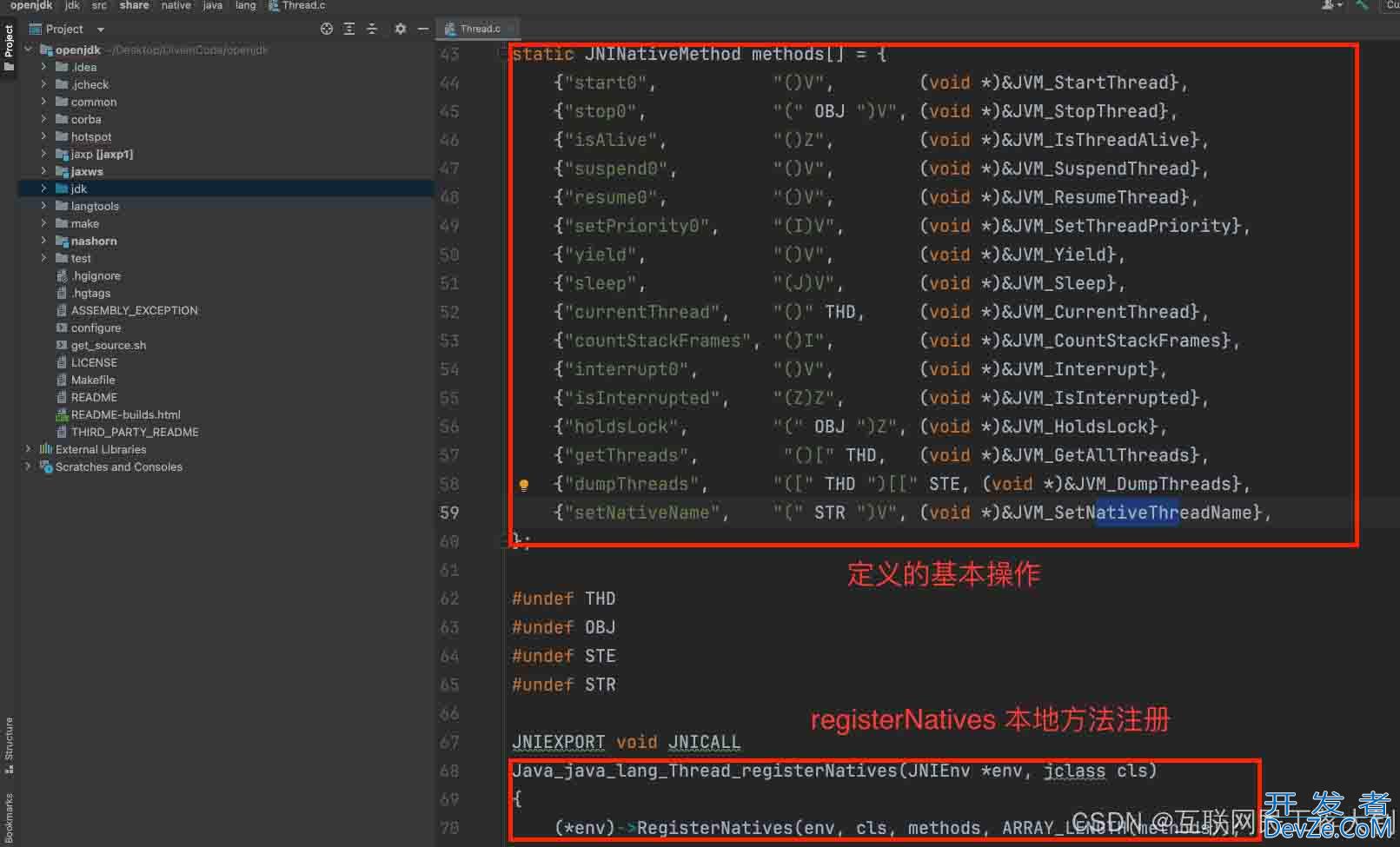
或者直接阅读 openjdk8 在线的源码:
https://hg.openjdk.org/jdk8/jdk8/jdk/file/687fd7c7986d/src/share/native/java/lang/Thread.c
2.2. Thread 中的成员变量
针对其中常见的几个变量做了中文注释
// 当前线程的名称
private volatile String name;
private int priority;
private Thread threadQ;
private long eetop;
/* Whether or not to single_step this thread. */
private boolean single_step;
// 当前线程是否在后台运行
/* Whether or not the thread is a daemon thread. */
private boolean daemon = false;
/* JVM state */
private boolean stillborn = false;
// init 构造方法中传入的执行任务,当其不为空时,会执行此任务
/* What will be run. */
private Runnable target;
// 当前线程所在的线程组
/* The group of this thread */
private ThreadGroup group;
// 当前线程的类加载器
/* The context ClassLoader for this thread */
private ClassLoader contextClassLoader;
/* The inherited AccessControlContext of this thread */
private AccessControlContext inheritedAccessControlContext;
// 被用来定义 "Thread-" + nextThreadNum() 的线程名,自增的序号在线程池打印日志中很常见
// 静态变量 threadInitNumber 在 static synchronized 方法中自增,这个方法被调用时在 Thread.class 类上加 synchronized 锁,保证单台 JVM 虚拟机上都通过 Thread.class 并发创建线程 init 时,线程自增序号的并发安全
/* For autonumbering anonymous threads. */
private static int threadInitNumber;
private static synchronized int nextThreadNum() {
return threadInitNumber++;
}
// 每个线程都维护一个 ThreadLocalMap,这个在保障线程安全的 ThreadLocal 中经常出现
/* ThreadLocal values pertaining to this thread. This map is maintained
* by the ThreadLocal class. */
ThreadLocal.ThreadLocalMap threadLocals = null;
/*
* InheritableThreadLocal values pertaining to this thread. This map is
* maintained by the InheritableThreadLocal class.
*/
ThreadLocal.ThreadLocalMap inheritableThreadLocals = null;
/*
* The requested stack size for this thread, or 0 if the creator did
* not specify a stack size. It is up to the VM to do whatever it
* likes with this number; some VMs will ignore it.
*/
private long stackSize;
/*
* JVM-private state that persists after native thread termination.
*/
private long nativeParkEventPointer;
/*
* Thread ID
*/
private long tid;
/* For generating thread ID */
private static long threadSeqNumber;
/* Java thread status for tools,
* initialized to indicate thread 'not yet started'
*/
private volatile int threadStatus = 0;
private static synchronized long nextThreadID() {
return ++threadSeqNumber;
}
/**
* The argument supplied to the current call to
* java.util.concurrent.locks.LockSupport.park.
* Set by (private) java.util.concurrent.locks.LockSupport.setblocker
* Accessed using java.util.concurrent.locks.LockSupport.getBlocker
*/
volatile Object parkBlocker;
/*编程客栈 The object in which this thread is blocked in an interruptible I/O
* operation, if any. The blocker's interrupt method should be invoked
* after setting this thread's interrupt status.
*/
private volatile Interruptible blocker;
private final Object blockerLock = new Object();
/* Set the blocker field; invoked via sun.misc.SharedSecrets from java.nio code
*/
void blockedOn(Interruptible b) {
synchronized (blockerLock) {
blocker = b;
}
}
/**
* The minimum priority that a thread can have.
*/
public final static int MIN_PRIORITY = 1;
/**
* The default priority that is assigned to a thread.
*/
public final static int NORM_PRIORITY = 5;
/**
* The maximum priority that a thread can have.
*/
public final static int MAX_PRIORITY = 10;
2.3. Thread 构造方法与初始化
构造方法:
Thread 具有多个重载的构造函数,内部都是调用 Thread#init() 方法初始化,我们常用的就是传入 Thread(Runnable target) 以及 Thread(Runnable target, String name)
public Thread() {
init(null, null, "Thread-" + nextThreadNum(), 0);
}
public Thread(Runnable target) {
init(null, target, "Thread-" + nextThreadNum(), 0);
}
Thread(Runnable target, AccessControlContext acc) {
init(null, target, "Thread-" + nextThreadNum(), 0, acc, false);
}
public Thread(ThreadGroup group, Runnable target) {
init(group, target, "Thread-" + nextThreadNum(), 0);
}
public Thread(String name) {
init(null, null, name, 0);
}
public Thread(ThreadGroup group, String name) {
init(group, null, name, 0);
}
public Thread(Runnable target, String name) {
init(null, target, name, 0);
}
public Thread(ThreadGroup group, Runnable target, String name) {
init(group, target, name, 0);
}
public Thread(ThreadGroup group, Runnable target, String name,
long stackSize) {
init(group, target, name, stackSize);
}
init 初始化方法:
主要完成成员变量赋值的操作,包括 Runnable target 变量的赋值。后面可以看到,如果在构造器中就传入这个 Runnable,Thread#run 就会执行这个 Runnable.
private void init(ThreadGroup g, Runnable target, String name,
long stackSize, AccessControlContext acc,
boolean inheritThreadLocals) {
if (name == null) {
throw new NullPointerException("name cannot be null");
}
this.name = name;
Thread parent = currentThread();
SecurityManager security = System.getSecurityManager();
if (g == null) {
/* Determine if it's an applet or not */
/* If there is a security manager, ask the security manager
what to do. */
if (security != null) {
g = security.getThreadGroup();
}
/* If the security doesn't have a strong opinion of the matter
use the parent thread group. */
if (g == null) {
g = parent.getThreadGroup();
}
}
/* checkAccess regardless of whether or not threadgroup is
explicitly passed in. */
g.checkAccess();
/*
* Do we have the required permissions?
*/
if (security != null) {
if (isCCLOverridden(getClass())) {
security.checkPermission(SUBCLASS_IMPLEMENTATION_PERMISSION);
}
}
g.addUnstarted();
this.group = g;
this.daemon = parent.isDaemon();
this.priority = parent.getPriority();
if (security == null || isCCLOverridden(parent.getClass()))
this.contextClassLoader = parent.getContextClassLoader();
else
this.contextClassLoader = parent.contextClassLoader;
this.inheritedAccessControlContext =
acc != null ? acc : AccessController.getContext();
// 就是上面成员变量中的 target,在这里赋值
this.target = target;
setPriority(priority);
if (inheritThreadLocals && parent.inheritableThreadLocals != null)
this.inheritableThreadLocals =
ThreadLocal.createInheritedMap(parent.inheritableThreadLocals);
/* Stash the specified stack size in case the VM cares */
this.stackSize = stackSize;
/* Set thread ID */
tid = nextThreadID();
}
2.4. Thread 线程状态与操作系统状态
public enum State {
/**
* Thread state for a thread which has not yet started.
*/
// 初始化状态
NEW,
/**
* Thread state for a runnable thread. A thread in the runnable
* state is executing in the Java virtual MAChine but it may
* be waiting for other resources from the operating system
* such as processor.
*/
// 可运行状态,可运行状态可以包括:运行中状态和就绪状态。
RUNNABLE,
/**
* Thread state for a thread blocked waiting for a monitor lock.
* A thread in the blocked state is waiting for a monitor lock
* to enter a synchronized block/method or
* reenter a synchronized block/method after calling
* {@link Object#wait() Object.wait}.
*/
// 线程阻塞状态
BLOCKED,
/**
* Thread state for a waiting thread.
* A thread is in the waiting state due to calling one of the
* following methods:
* <ul>
* <li>{@link Object#wait() Object.wait} with no timeout</li>
* <li>{@link #join() Thread.join} with no timeout</li>
* <li>{@link LockSupport#park() LockSupport.park}</li>
* </ul>
*
* <p>A thread in the waiting state is waiting for another thread to
* perform a particular action.
*
* For example, a thread that has called <tt>Object.wait()</tt>
* on an object is waiting for another thread to call
* <tt>Object.notify()</tt> or <tt>Object.notifyAll()</tt> on
* that object. A thread that has called <tt>Thread.join()</tt>
* is waiting for a specified thread to terminate.
*/
// 等待状态
WAITING,
/**
* Thread state for a waiting thread with a specified waiting time.
* A thread is in the timed waiting state due to calling one of
* the following methods with a specified positive waiting time:
* <ul>
* <li>{@link #sleep Thread.sleep}</li>
* <li>{@link Object#wait(long) Object.wait} with timeout</li>
* <li>{@link #join(long) Thread.join} with timeout</li>
* <li>{@link LockSupport#parkNanos LockSupport.parkNanos}</li>
* <li>{@link LockSupport#parkUntil LockSupport.parkUntil}</li>
* </ul>
*/
// 超时等待状态
TIMED_WAITING,
/**
* Thread state for a terminated thread.
* The thread has completed execution.
*/
// 线程终止状态
TERMINATED;
}
- NEW: 初始状态,线程被构建,但是还没有调用 Thread#start() 方法
- RUNNABLE: 可运行状态,包括运行中和就绪状态。从源码的注释中可以看出来,就绪状态就是线程在 JVM 中有资格运行,但是由于操作系统调度的原因尚未执行,可能线程在等待操作系统释放资源,比方说处理器资源。
- BLOCKED: 阻塞状态,处于这个状态的线程等待别的线程释放 monitor 锁以进入 synchronized 块;或者调用 Object#wait() 方法释放锁进入等待队列后(此时是 WAITING 状态),被其他线程 notify() 唤醒时不能立刻从上次 wait 的地方恢复执行,再次进入 synchronized 块还需要和别的线程竞争锁。
- 总结来说,线程因为获取不到锁而无法进入同步代码块时,处于 BLOCKED 阻塞状态。
- WAITING: 等待状态,处于该状态的线程需要其他线程对其进行通知或者中断等操作,从而进入下一个状态。
- TIMED_WAITING: 超时等待状态,相比于 WAITING 状态持续等待,该状态可以在一定时间后自行返回
- TERMINATED: 终止状态,当前线程执行完毕
下面就用一张图表示了Java线程各种状态的流转,其中夹杂着操作系统线程的状态定义,其中标红的部分表示 Java 状态
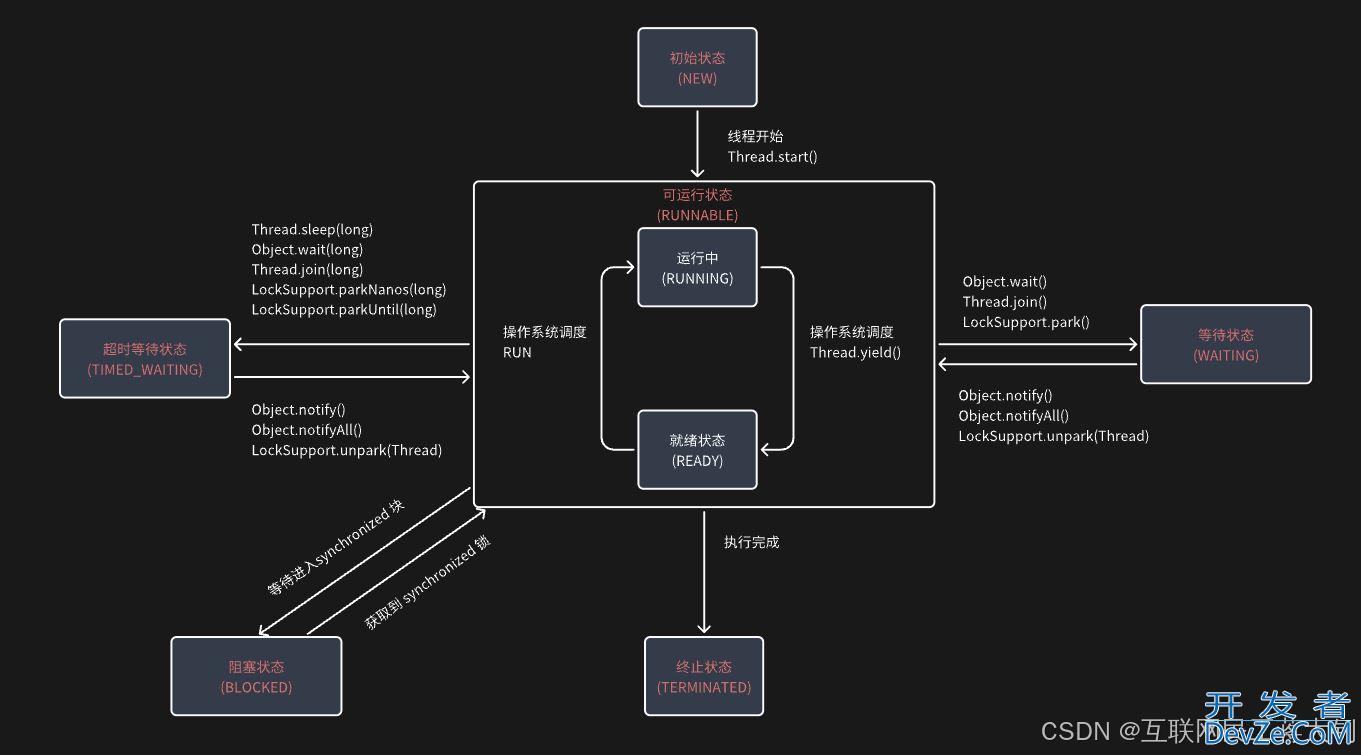
对比操作系统线程状态,包括 new、terminated、ready、running、waiting,除去初始化 new 和 terminated 终止状态,一个线程运行中的状态只有:
- ready: 线程已创建,等待系统调度分配 CPU 资源
- running: 线程获得了 CPU 使用权,正在运算
- waiting: 线程等待(或者说挂起),让出 CPU 资源给其他线程使用
其对应关系我理解如下:
其中 Java 线程状态 RUNNABLE 包括操作系统状态的运行 running 和就绪 ready,操作系统的 waiting 包含了 BLOCKED 阻塞挂起状态。

2.4. start() 与 run() 方法
新线程构造之后,只有调用 start() 才能让 JVM 创建线程并进入运行状态,Thread#start() 源码如下,主要包含几大步骤:
- 判断线程状态是否为 NEW 初始化
- 加入线程组
- 调用 native 方法 start0() 通知底层 JVM 启动一个线程,start0() 就是前面 registerNatives() 本地方法注册的一个启动方法
- 如果启动失败,把线程从线程组中删除
public synchronized void start() {
/**
* This method is not invoked for the main method thread or "system"
* group threads created/set up by the VM. Any new functionality added
* to this method in the future may have to also be added to the VM.
*
* A zero status value corresponds to state "NEW".
*/
// 1. 判断线程状态是否为 NEW 初始化,否则直接抛出异常
if (threadStatus != 0)
throw new IllegalThreadStateException();
/* Notify the group that this thread is about to be started
* so that it can be added to the group's list of threads
* and the group's unstarted count can be decremented. */
// 2. 加入线程组
group.add(this);
// 线程是否已经启动标志位,启动后设置为 true
boolean started = false;
try {
// 3. 调用本地方法启动线程
start0();
// 启动后设置标志位为 true
started = true;
} finally {
try {
// 4. 如果启动失败,把线程从线程组中移除
if (!started) {
group.threadStartFailed(this);
}
} catch (Throwable ignore) {
/* do nothing. If start0 threw a Throwable then
it will be passed up the call stack */
}
}
}
// JVM 真正启动线程的本地方法
private native void start0();
从 start() 源码中可以看出来以下几点:
- start() 加上 synchronized 关键词,单个 Thread 实例在这个 JVM 进程中运行是同步的,因此不会出现并发问题。同步检查该线程的状态,如果不是初始化状态则抛出异常。
- start() 方法并没有直接调用我们定义的 run() 方法,是因为 Thread#start() 底层调用 Thread#start0(),start0() 的本地方vYpfHvWCL法逻辑中会调用 run() 方法
- 直接调用 Thread#run() 方法或者 Runnable#run() 方法不会创建新线程执行任务,而是在主线程直接串行执行,如果要创建新线程执行任务,需要调用 Thread#start() 方法
调用逻辑图如下:
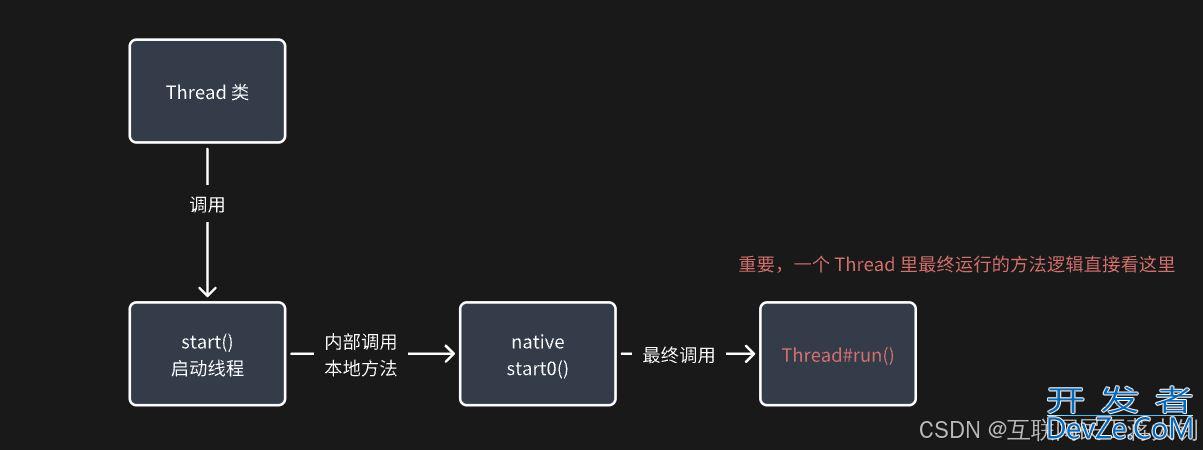
Thread#run() 源码如下:
// 自定义重写 Thread#run() 或者传入 Runnable,最终都会调用该线程的 run() 方法逻辑
// 如果传入了 Runnable 就会走进这个方法运行 target.run(),有点装饰器模式的感觉
@Override
public void run() {
if (target != null) {
target.run();
}
}
至于为何最终 start0() 还是调用了 Thread#run(),这就需要去看 jdk 源码了,我刚好也硬着头皮去挖了下:
首先看到 Thread.c 文件中 registerNatives 里面注册的这些本地方法,start0() 会去调用 JVM_StartThread

在 jvm.cpp 文件中找出 JVM_StartThread 方法,其底层调用 new JavaThread()方法
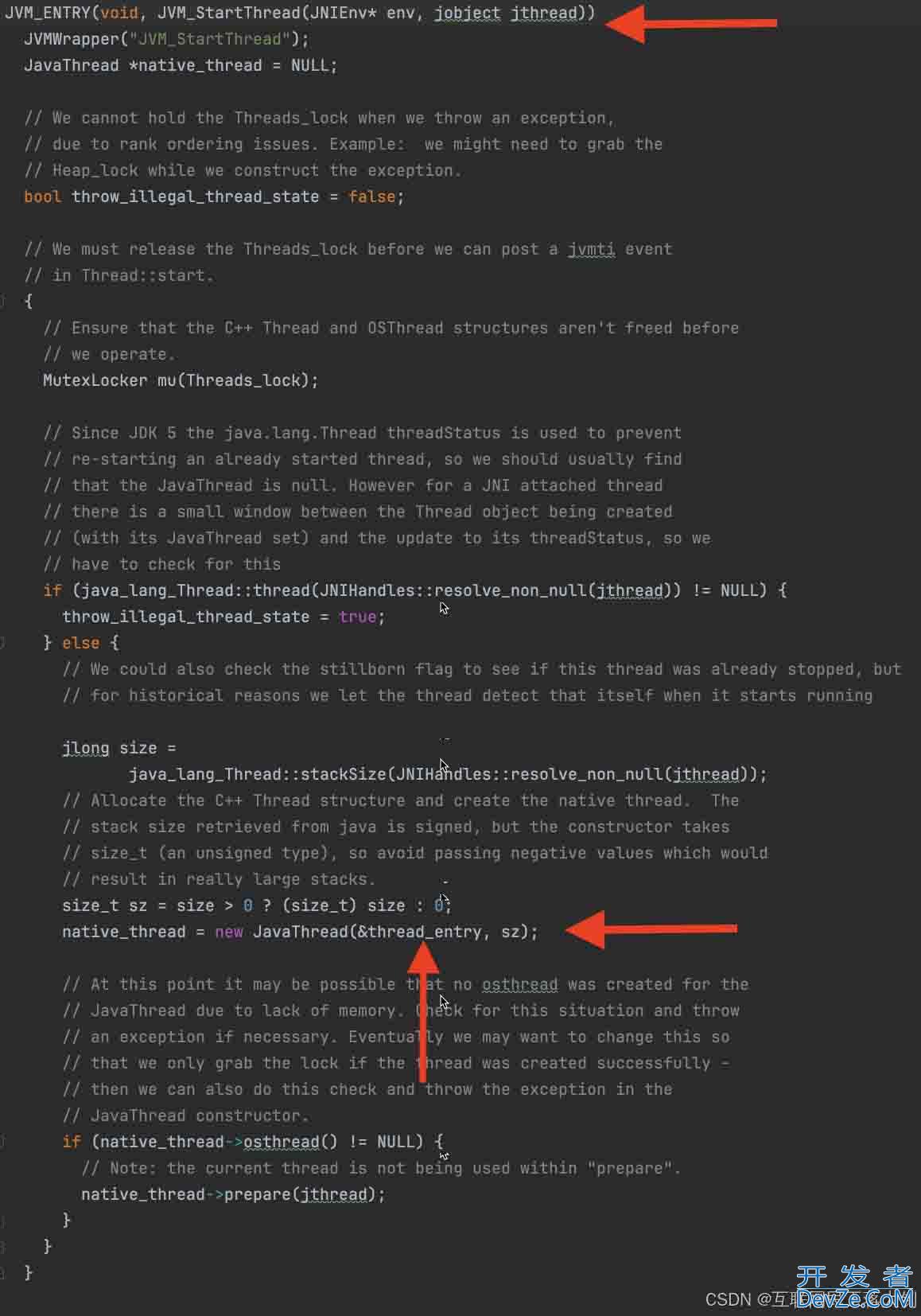
最终该方法真的会去 thread.cpp 里调用创建操作系统线程的方法 os::create_thread
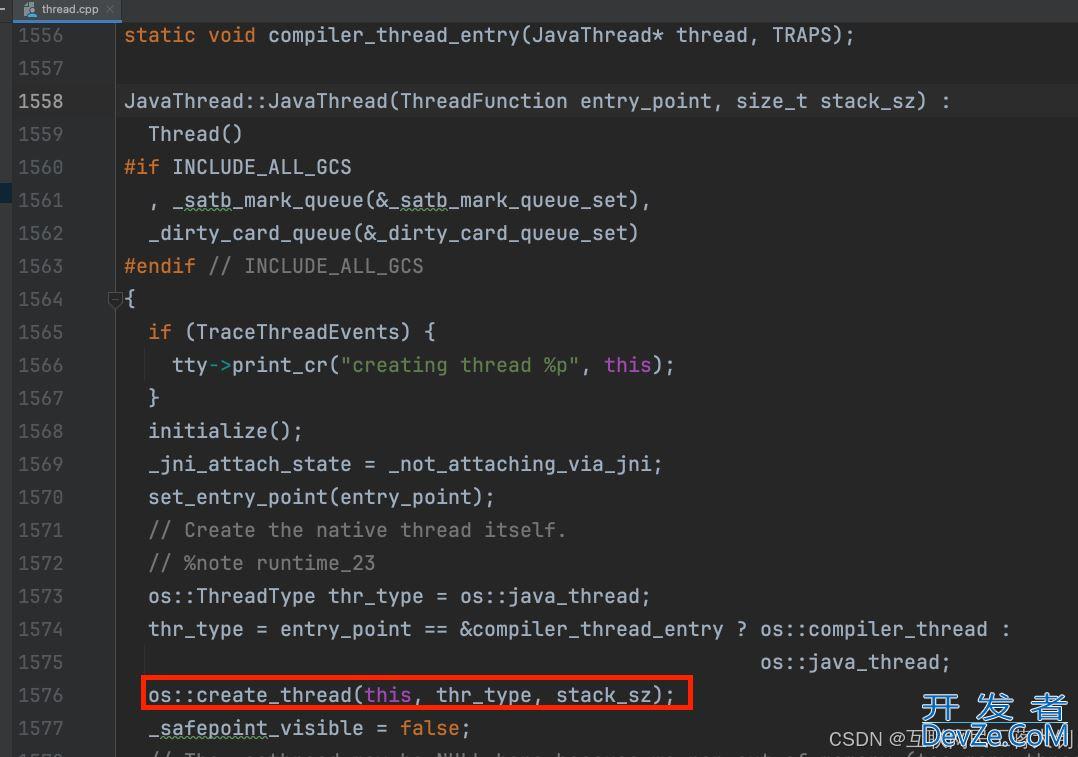
new JavaThread() 方法里面会引用 jvm.cpp 文件中的 thread_entry 方法,这个方法最终就会调用 vmSymbols::run_method_name(),看起来是个虚拟机内注册的方法
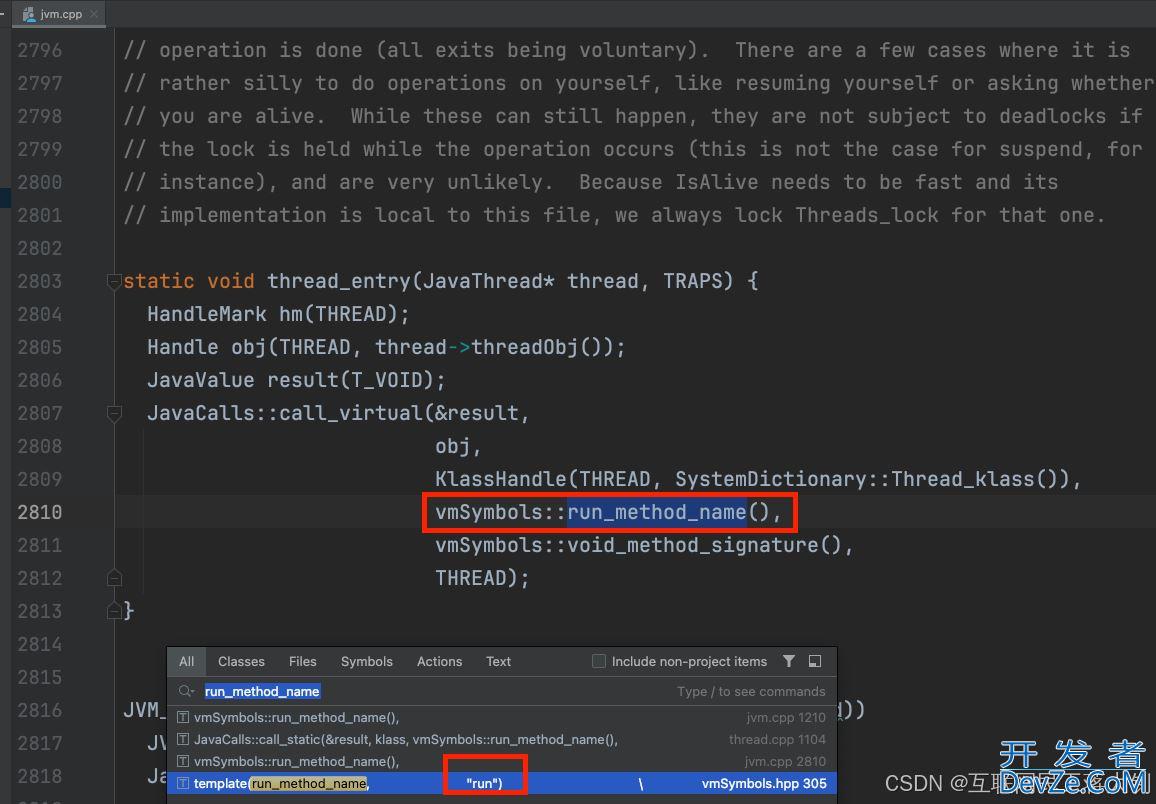
全局检索一下,其实就是在 vmSymbols.hpp 头文件中定义的许多通用方法和变量,run 方法刚好是其中定义的一个,也就是 Thread#run()。
还可以看到许多其他常见的方法,比方说类的初始化方法,是 jvm 第一次加载 class 文件时调用,包括静态变量初始化语句和静态块执行。
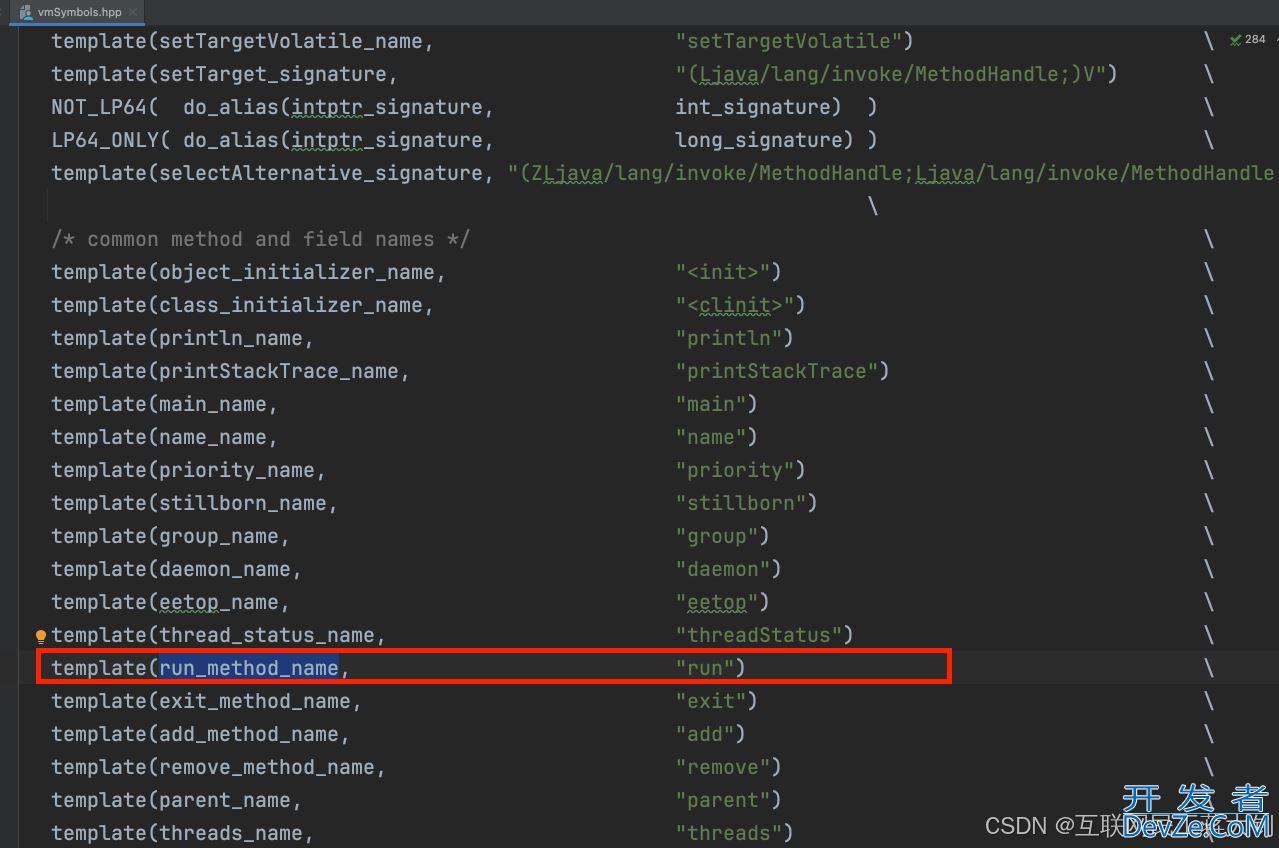
2.5. sleep() 方法
Thread#sleep() 方法会让当前线程休眠一段时间,单位为毫秒,由于是 static 方法,所以是让直接调用 Thread.sleep() 的休眠,这里需要注意的是:
调用 sleep() 方法使线程休眠以后,不会释放自己占有的锁。
// 本地方法,真正让线程休眠的方法
public static native void sleep(long millis) throws InterruptedException;
/**
* Causes the currently executing thread to sleep (temporarily cease
* execution) for the specified number of milliseconds plus the specified
* number of nanoseconds, subject to the precision and accuracy of system
* tiwww.devze.commers and schedulers. The thread does not lose ownership of any
* monitors.
*
* @param millis
* the length of time to sleep in milliseconds
*
* @param nanos
* {@code 0-999999} additional nanoseconds to sleep
*
* @throws IllegalArgumentException
* if the value of {@code millis} is negative, or the value of
* {@code nanos} is not in the range {@code 0-999999}
*
* @throws InterruptedException
* if any thread has interrupted the current thread. The
* <i>interrupted status</i> of the current thread is
* cleared when this exception is thrown.
*/
public static void sleep(long millis, int nanos)
throws InterruptedException {
if (millis < 0) {
throw new IllegalArgumentException("timeout value is negative");
}
if (nanos < 0 || nanos > 999999) {
throw new IllegalArgumentException(
"nanosecond timeout value out of range");
}
if (nanos >= 500000 || (nanos != 0 && millis == 0)) {
millis++;
}
// 调用本地方法
sleep(millis);
}
2.6. join() 方法
这个方法是目前我觉得 Thread 里面最难理解的方法了,涉及到 synchronized 锁、wait、notify 原理,以及线程调用主体之间的辨析,参考 【Java】Thread类中的join()方法原理,我的理解如下:
首先看下 Thread#join() 方法的源码:
非静态方法,是类中的普通方法,比方说 Main 线程调用 ThreadA.join(),就是 Main 线程会等待 ThreadA 执行完成
// 调用方法,比方说 Main 线程调用 ThreadA.join(),就是 Main 线程会等待 ThreadA 执行完成
public final void join() throws InterruptedException {
join(0);
}
public final synchronized void join(long millis)
throws InterruptedException {
long base = System.currentTimeMillis();
long now = 0;
if (millis < 0) {
throw new IllegalArgumentException("timeout value is negative");
}
if (millis == 0) {
// 该分支是无限期等待js ThreadA 结束,其实内部最后是在 ThreadA 结束时被 notify
while (isAlive()) {
wait(0);
}
} else {
// 该分支时等待有限的时间,如果 ThreadA 在 delay 时间以后还未结束,等待线程也返回了
while (isAlive()) {
long delay = millis - now;
if (delay <= 0) {
break;
}
wait(delay);
now = System.currentTimeMillis() - base;
}
}
}
重点关注下其中会出现的两个 wait():
首先我们知道,Object#wait() 需要放在 synchronized 代码块中执行,即获取到锁以后再释放掉锁。
这个 synchronized 锁就是在 Thread#join() 方法上,成员方法上加了 synchronized 说明就是 synchronized(this)android, 假设 Main 线程调用 ThreadA.join(),那么这个 this 就是指调用 ThreadA.join() 的 ThreadA 对象本身,最终效果就是,调用方 Main 线程持有了 ThreadA 对象的 Monitor 锁,被记录在 ThreadA 对象头上。
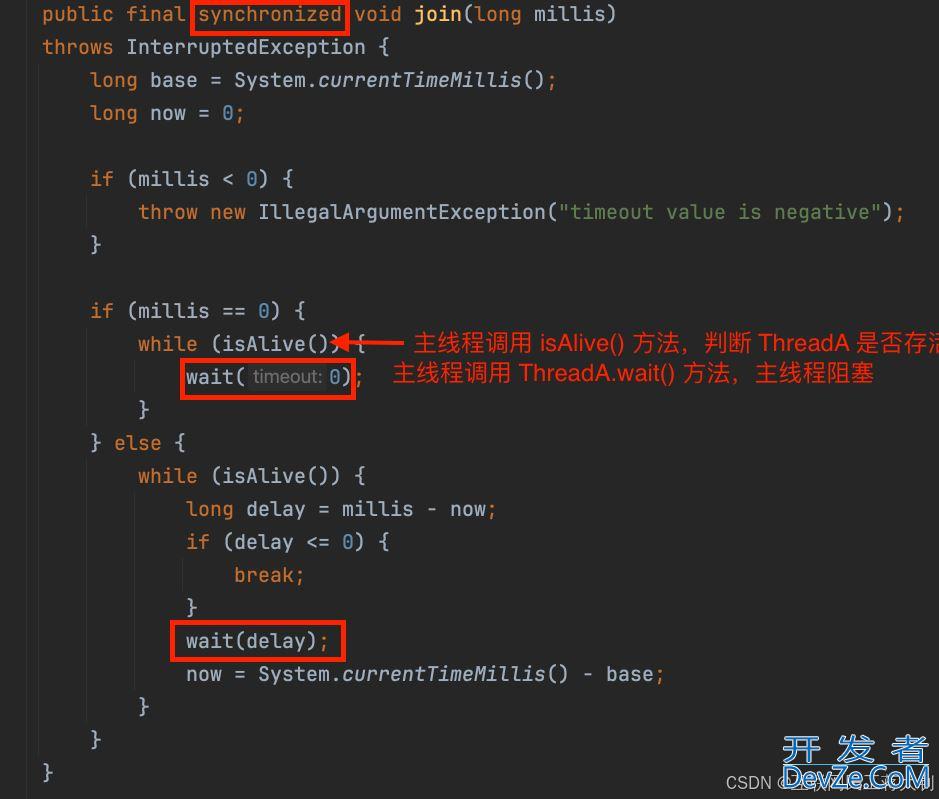
有了 Object#wait() 就需要有对应的 Object#notify() 将其唤醒,这又得看到 jvm 源码里面去了
在 openjdk/hotspot/src/share/vm/runtime/thread.cpp 的 JavaThread::exit 方法中,这其实是线程退出时会执行的方法,有个 ensure_join() 方法
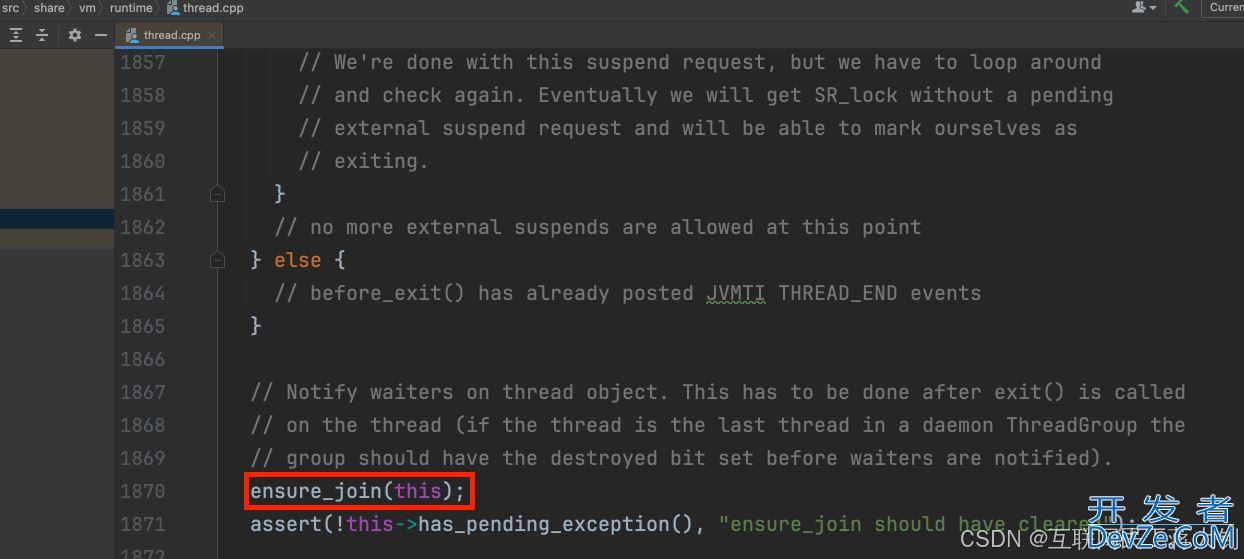
ensure_join() 方法的源码如下:
上面的 this 就是指 ThreadA,就是下面方法入参中的 thread。可以看出来,当线程 ThreadA 执行完成准备退出时,jvm 会自动唤醒等待在 threadA 对象上的线程,在我们的例子中就是主线程。
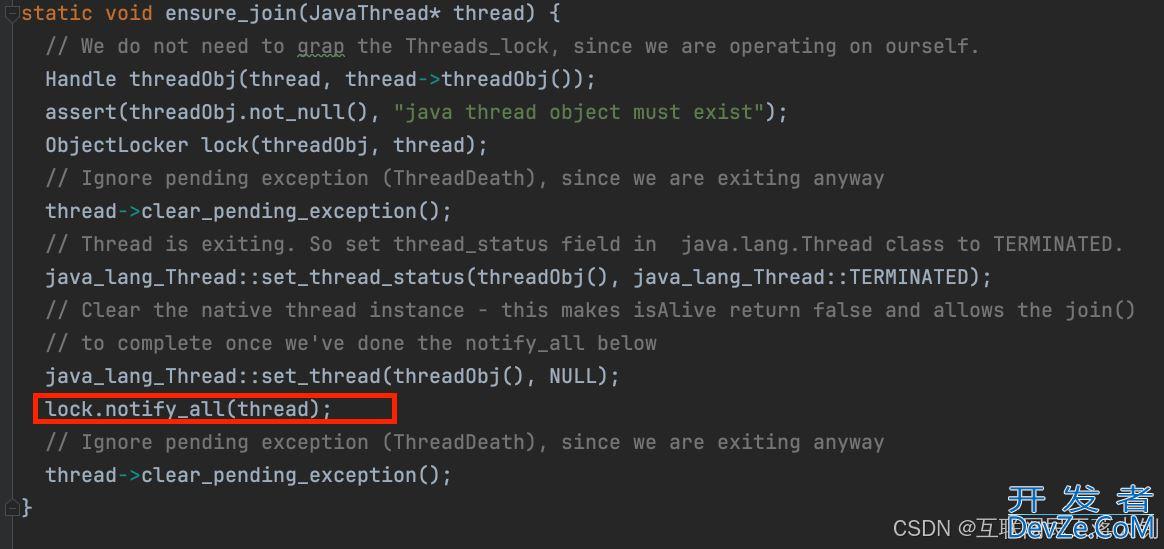
总结如下:
Thread.join() 方法底层原理是 synchronized 方法 + wait/notify。主线程调用 ThreadA.join() 方法,通过 synchronized 关键字获取到 ThreadA 的对象锁,内部再通过 Object#wait() 方法等待,这里的执行方和调用方都是主线程,最终当 ThreadA 线程退出的时候,jvm 会自动 notify 唤醒等待在 ThreadA 上的线程,也就是主线程。
2.7. interrupt() 方法
Thread#interrupt 是中断被调用线程的方法,它通过设置线程的中断标志位来中断被调用线程,通常调用会抛出 java.lang.InterruptedException 异常。
这种中断线程的方法比较安全,能够使正在执行的任务继续能够执行完,而不像 stop() 方法那样强制关闭。
public void interrupt() {
if (this != Thread.currentThread())
checkAccess();
synchronized (blockerLock) {
Interruptible b = blocker;
if (b != null) {
interrupt0(); // Just to set the interrupt flag
b.interrupt(this);
return;
}
}
// 调用本地方法中断线程
interrupt0();
}
总结
以上为个人经验,希望能给大家一个参考,也希望大家多多支持编程客栈(www.devze.com)。
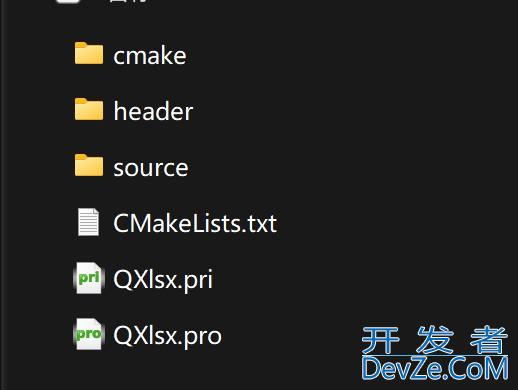




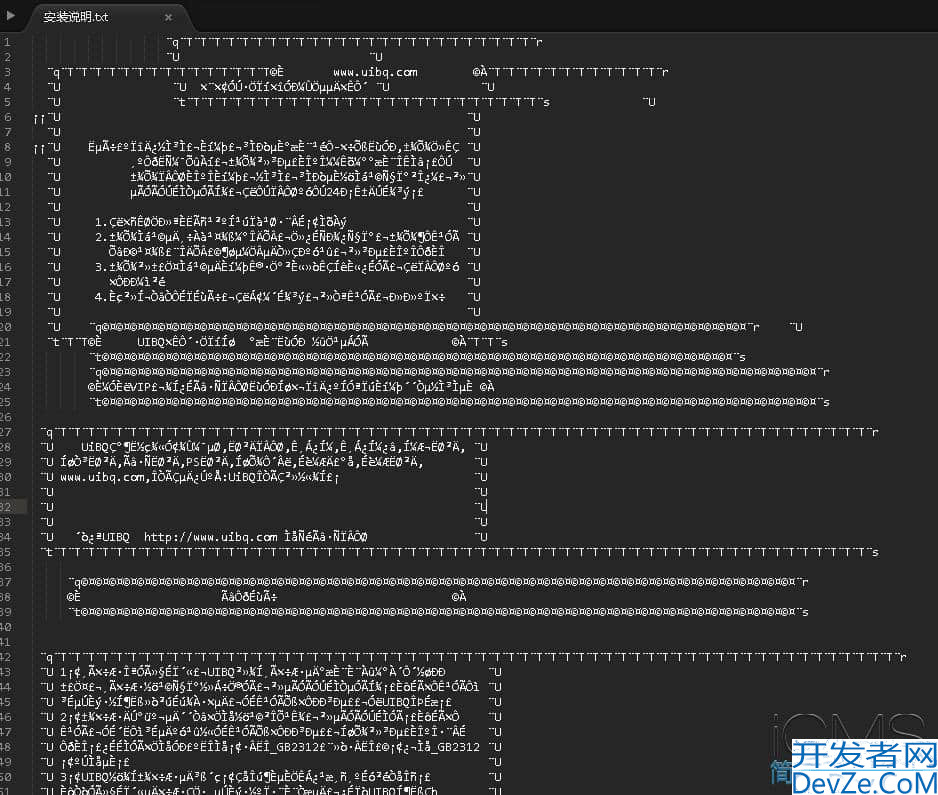
 加载中,请稍侯......
加载中,请稍侯......
精彩评论